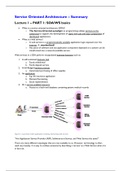Samenvatting
Summary Service Oriented Architecture
- Instelling
- Tilburg University (UVT)
Samenvatting voor Service Oriented Architecture (SOA). Laatste pagina heeft een klein overzicht van de naar mijn mening belangrijkste concepten en leeronderwerpen. Afgesloten met een 9.0.
[Meer zien]




